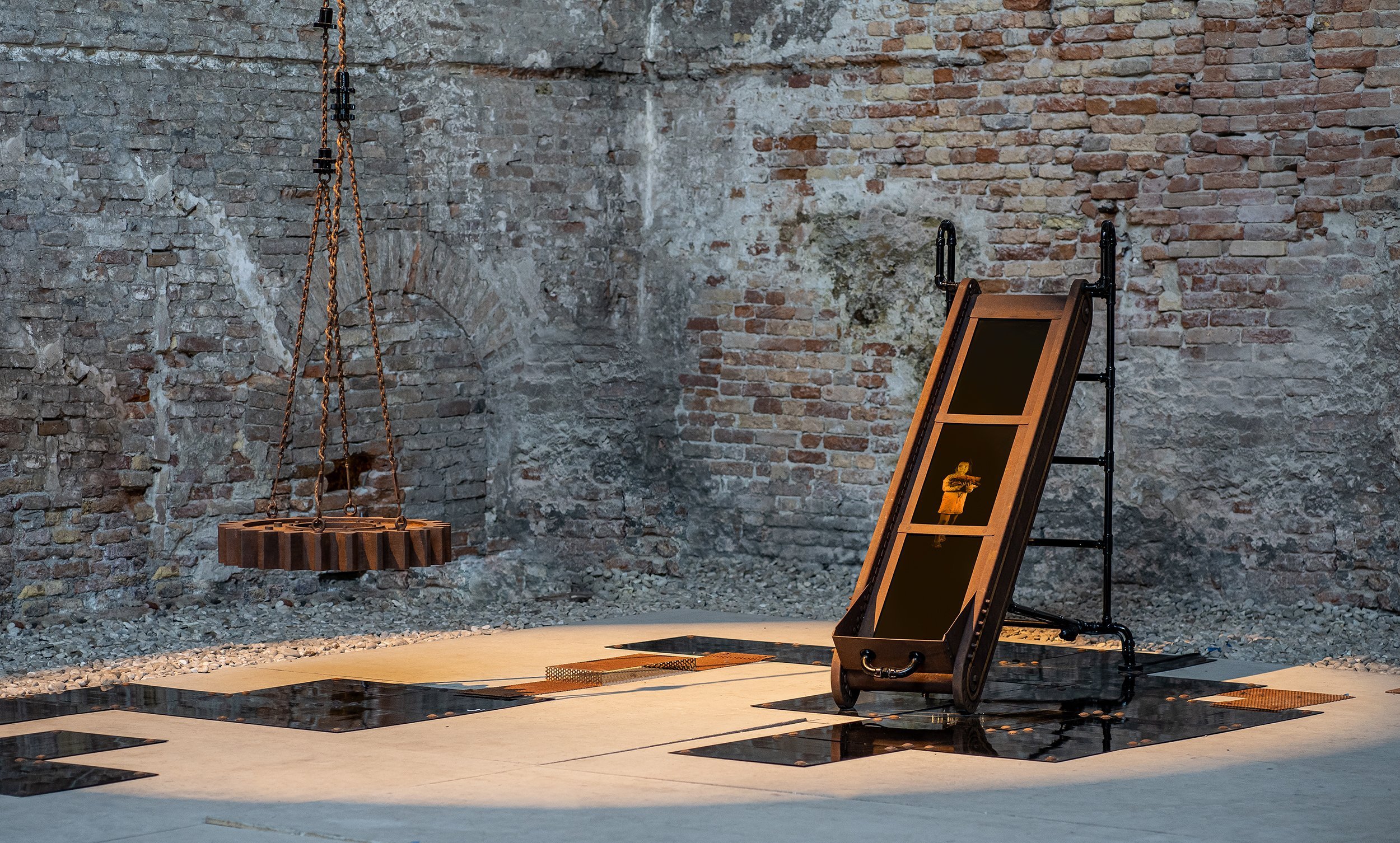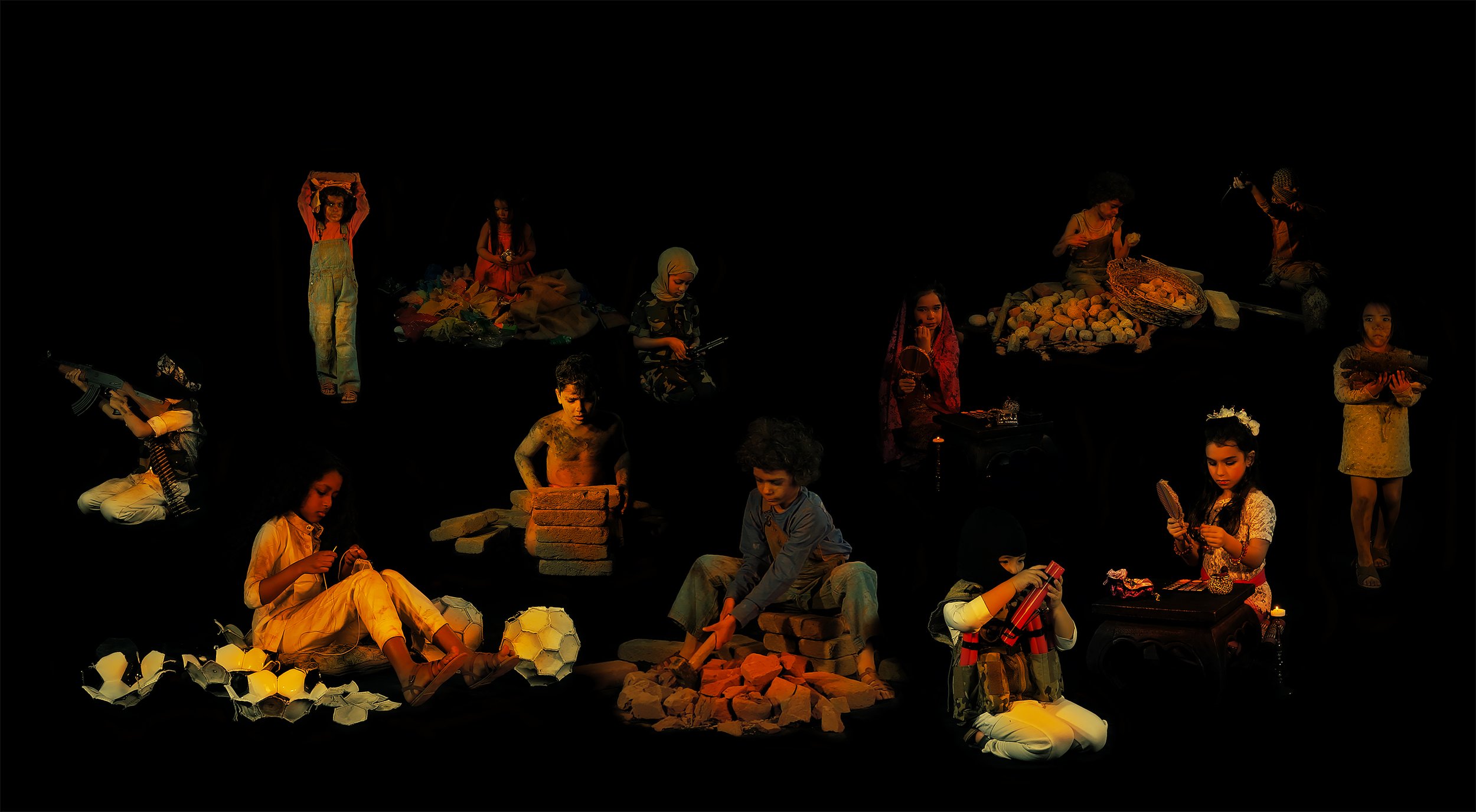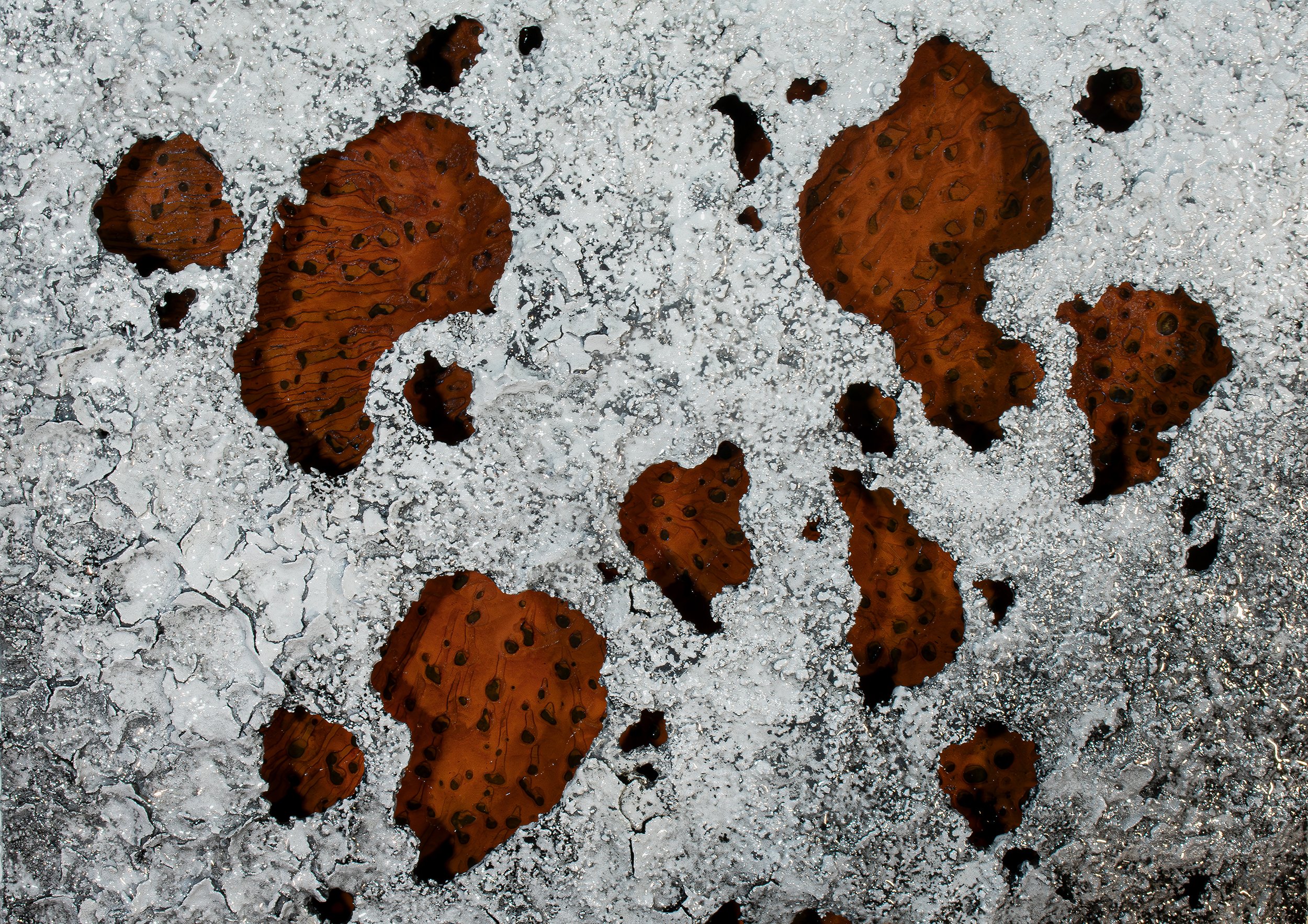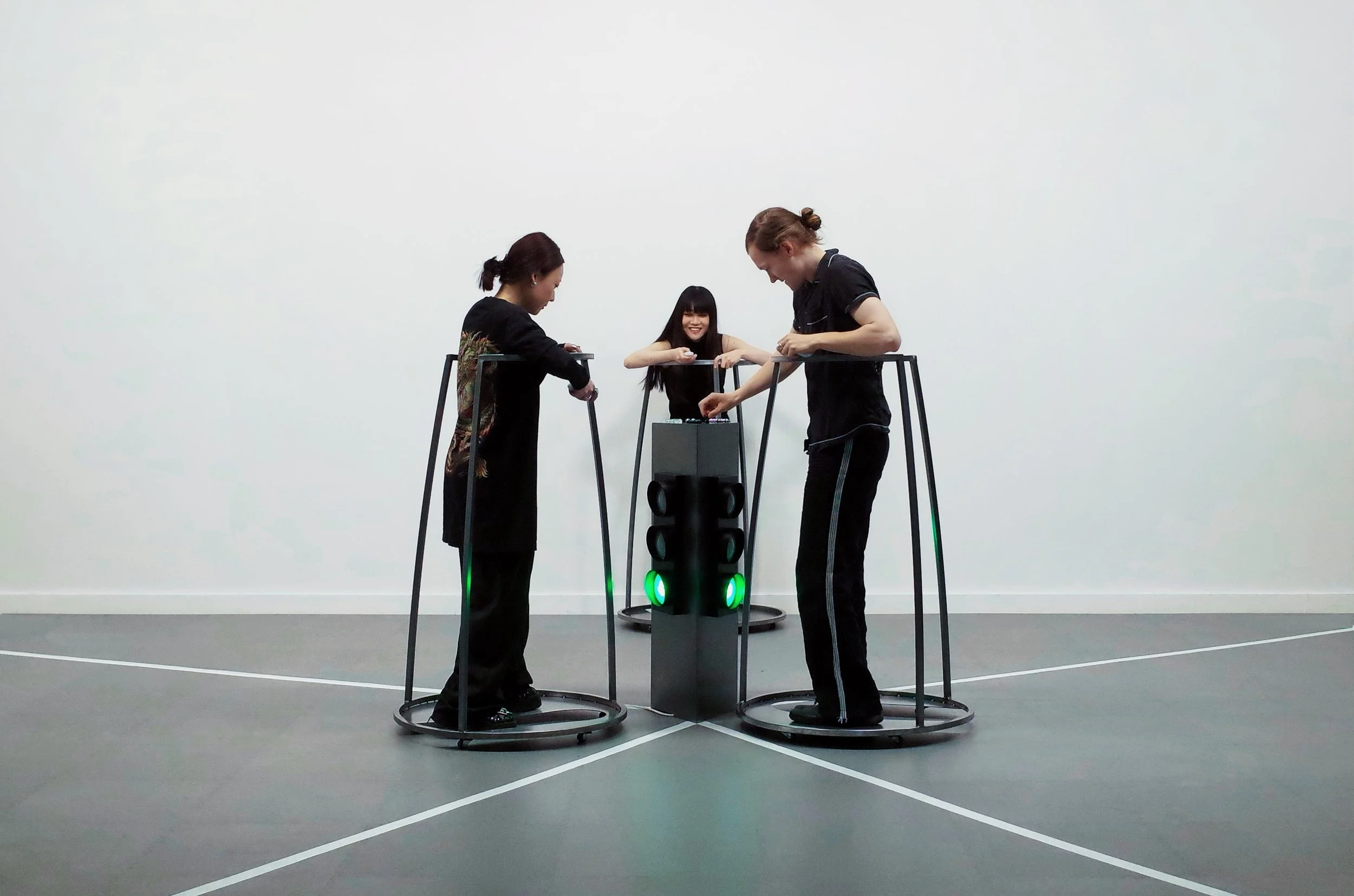10 Questions with Anna Skoromnaya
Anna Skoromnaya (b. 1986, Minsk, Belarus) is an artist who lives and works in Genoa, Italy. She is a graduate of the Florence Academy of Fine Arts (2013) and lecturer at the Academy of Fine Arts of Sanremo.
In her genre-bending site-specific installations and video sculptures, in which physical forms and digital technologies simultaneously coexist and collide, Skoromnaya employs dualities of meanings and shapes and juxtaposes materials and symbols to address the theme of the paradoxes of contemporary society.
She has won and been shortlisted for various national and international awards: winner of the Art Nova 100 Special Prize at the 15th Arte Laguna Prize and winner of the Special Mention at the Trento Art Prize 2022; Exibart Prize 2021 and 16th Arte Laguna Prize finalist; representing Italy at the JCE Contemporary Art Biennale 2019-2021 and overall winner of the Arteam Cup 2017. She has had solo exhibitions at the Unipol Group’s CUBO museum (Bologna), Must Gallery (Lugano), ‘The Others’ art fair (Turin) and Trento Art Festival. Recent group exhibitions include shows at the Arsenale of Venice, the Guardian Art Center (Beijing), Le Beffroi de Montrouge (Paris), the Art Building in Vrå – The Engelund Collection (Hjørring, Denmark), the Museu de l'Empordà (Figueres, Spain), the Amadeo de Souza-Cardoso Municipal Museum (Amarante, Portugal), as well as the exhibition ‘Stand For Girls’ at Fabbrica del Vapore (Milan) and the curatorial project ‘SAATCHI SCREEN’ at the Saatchi Gallery (London).
Anna Skoromnaya - Portrait
ARTIST STATEMENT
Anna Skoromnaya is an interdisciplinary artist who works predominantly with installations and media based on moving images, such as videos, holograms and computer- and software-generated figures. Skoromnaya’s artistic practice incorporates both sophisticated, innovative media and intentionally contaminated materials, with a language that focuses on and magnifies the paradoxes present in our society. Her art simultaneously confronts the spectator with the contradictions of an ideal, almost fairy-tale dimension and the cruel reality, revealing explosive and excruciating contrasts between technological progress and the various ways in which the most vulnerable people in the modern world are exploited.
“Skoromnaya knows how to make us reflect by raising insoluble, insolvable questions, and this incessant new questioning awakens the ethics of a work that never ends at the moment it is seen, but remains stitched to (and inside) those who see it.”
Cotton Candy Maker, painted iron, 2 Full HD monitors, plush fabric, Bose speakers, audio, 250 x 250 x 150 cm, 2019 © Anna Skoromnaya
Installation view Al-Tiba9 gallery, Barcelona, Spain, 2023
INTERVIEW
Let’s start by talking a little about yourself. What is your personal and artistic background?
My background is in two different parts of the world, first Belarus and then Italy, and this has shaped both my personal and artistic identity. The combination of different cultural influences has helped me develop a complex and multi-layered vision, which tends to resist anything purely decorative or one-sided. I am interested in the myriad aspects encompassed by human nature and modern society, particularly the starkest contrasts and most paradoxical elements. My initial highly institutional and figurative academic background led to me developing a thirst for innovation and a love for anything unique and unconventional. I find this duality absolutely fascinating, and instil it into my work by using materials and techniques that can create contrasts and coexist, reflecting both the world’s complexity and its harmony.
Cotton Candy Maker # 3, painted iron, plush fabric, leather, 65 x 55 x 75 cm, 2023 © Anna Skoromnaya
How did you get interested in art and start working as an artist? And are you still following the same aspiration?
I think I was born with a spark of passion for art: I was heading outside to paint landscapes in watercolours from a very young age. Then my days became a blur of lessons, both at high school and privately in the evening with the city’s best artists, and I would often also carry on painting at home into the night. My biggest accomplishment was being accepted into the Academy of Fine Arts in Minsk, an elite establishment that only accepted seven aspiring painters each year. But although it gave me a solid academic grounding in the Russian school of painting, I felt restricted by the limitations of the traditional style, so I moved to Italy, where I studied in the prestigious environment of the Academy of Fine Arts in Florence. Today my inspiration remains as strong as ever: I want to escape the ordinary and celebrate that uncomfortable space where creativity can blossom.
As you mentioned, you are originally from Belarus but studied in Florence and are currently based in Italy. Do you find that moving to Italy helped you or inspired you in relation to your artistic work? Did you develop any specific concept or theme you wouldn’t have thought otherwise?
The world I came from has a well-established academic tradition, and this meant I was able to teach at the Academy of Fine Arts in Sanremo and to hold workshops at Yunnan University in China. However, having to doggedly defend the figurative artistic tradition can be suffocating for an artist who wants to experiment freely, and I found Italy provided a fertile environment for me to spread my wings. I love the complete freedom I have to express myself both in technical terms and regarding the content, including tackling delicate, provocative or uncomfortable topics like issues linked to differences in living conditions, human rights and the contradictions of contemporary society.
Cream Hand Mixer, Cor-Ten steel, painted iron, 4 Full HD monitors, video wall, Bose speakers, audio, 800 x 380 x 470 cm, 2017 © Anna Skoromnaya
Installation view Arsenale of Venice, Italy, 2023 | Photography: Teresa Letizia Bontà
Cream Hand Mixer # 2, Cor-Ten steel, painted iron, Full HD monitor, Bose speaker, audio, 800 x 70 x 70 cm, 2017 © Anna Skoromnaya
Installation view Arsenale of Venice, Italy, 2023 | Photography: Teresa Letizia Bontà
Speaking of your work, you primarily work with mixed media installation. How did you develop this practice? And why did you choose this medium specifically?
Like all of my generation, I grew up in an era of rapid digital change. I have always found that static materials and techniques lack something crucial: movement. I wanted to capture a dynamic fragment of life in an artwork and use it to convey the unique emotion of reality to spectators. After years of research, I developed an original technique, ‘dynamic light box’, for my first multimedia series SOS CODE: the variable position of the embedded LED light gives the impression that the figures are moving. As I continued my practice, I realised that I wanted to physically invade the space and move from two to three dimensions, while continuing to experiment with different technologies. I therefore started using the opposition between the media and sculptural components to highlight the theme of contrasts, and created several multimedia installations, each one employing different solutions. For example, when working on Popcorn Machine, I developed a unique shade of green translucent and frosted plexiglass, so that when the light passes through the plexiglass sections it reflects in a similar way to the customised holograms in the work.
Digital and moving images are central to your work, and you often incorporate them into your installations, creating layered pieces. How do you incorporate these images, and what would you like to communicate? Are those additional layers you use to clarify the work or contrasting points of view for the spectator to consider?
As well as presenting a contradictory juxtaposition of two different dimensions – fairy tales and reality – the moving images embedded in the various installations in the KINDERGARTEN series also have a conceptual meaning. Together, the installations in the series form an enormous and unconventional play park, recalling outdoor play equipment, colourful building blocks and giant jewellery. However, there are no children in this fairy-tale environment: only faint images of them incorporated into the objects, showing that they themselves have become toys in the hands of adults.
The stark contrasts in my expressive language – created, for example, by juxtaposing sculptural elements and evanescent media and rigid and soft materials, or through dialogue between various opposing meanings, symbols and forms – can be interpreted on multiple levels.
Sweet Corner, video wall, 10 Full HD monitors, audio, 55 x 303 x 687 cm, 2021 © Anna Skoromnaya
Installation view Arsenale of Venice, Italy, 2021
Sweet Carousel, video 1' 30'', audio, 2021 © Anna Skoromnaya
On a general level, what are the main themes you work with? And what do they represent for you?
The main theme of my work is the contradictions and paradoxes inherent both to the nature of individuals and the mechanisms of the whole of contemporary society. I like to divide up society from all viewpoints – in terms of generations, living conditions, places of origin, political views, culture and particularly behavioural and psychological aspects – before extrapolating and drawing attention to the most contradictory parts of each one. My SOS CODE series analyses relationships between individuals, reflecting on the lack of communication and the mechanisms used to exclude those who are seen as different. The KINDERGARTEN series, meanwhile, explores the paradoxical contrast between technological progress and the continued exploitation of the world’s most vulnerable people. I examined various ways that children’s rights are violated, such as child labour, child brides and female genital mutilation, as well as the use of minors as instruments of death in pseudo-religious terrorism.
I believe that art can be a powerful vehicle for raising awareness, encouraging reflection and debate and inspiring society to change, particularly when it explores uncomfortable areas.
Speaking of messages, you have participated in several exhibitions, including the latest Arte Laguna Prize in Venice. Generally speaking, what reactions do you receive from the public? Are the messages you want to communicate easily received?
My art undoubtedly requires a certain amount of commitment, open-mindedness and tolerance from both the spectator and the exhibitor or collector, but I am pleased to say that the reaction I get from the public is one of the most gratifying aspects of what I do. Whenever my works are exhibited, I always receive many positive comments and thanks from people who have particularly appreciated them. I have also enjoyed a warm welcome from a number of institutions: for example, my solo show at the Unipol CUBO museum in Bologna included several guided tours, attended by – among others – various international delegations and schools.
Untitled, OxiFLOWERing™, rusted iron, 60 x 50 x 7 cm, 2023 © Anna Skoromnaya
Untitled (detail), OxiFLOWERing™, rusted iron, 60 x 50 x 7 cm, 2023 © Anna Skoromnaya
Let’s now talk about the future. Are you working on any new project or series? Is there anything you would like to share with our readers?
I am excited to be able to share a preview of my next project, a series called OxiFLOWERing, which stems from my ongoing research into unconventional beauty using the medium of controlled corrosion. My art rebels against the world’s obsession with preservation and avoiding contamination, and instead embraces the transformation of materials as they age, evolve and corrode; I am convinced that in certain contexts there is still space for people’s innate search for happiness.
I was fascinated by the incredible uniqueness of the raised volumes and textures that various complex chemical processes could produce, and I continued to experiment, devising an entirely novel contamination technique I have named OxiFLOWERing™. The concept underpinning the series is found in the material’s transformation: while there are countless well-known products and techniques available for keeping ageing and contamination at bay, those who do not fit these stereotypes do not receive the same attention, and are often marginalised or swept under the carpet. My creative process therefore takes something society considers ‘ugly’ and gives rise to an unexpected aesthetic, like a plant coming into bloom. The OxiFLOWERing series therefore forces us to tackle the intrinsic duality of our world, and celebrates how, as a result of our humanity, beauty can even blossom from decay.
What are your plans for the future? Do you have any upcoming exhibitions or publications where our readers can find your work?
My practice combines profound and solitary immersion in my art with vibrant displays of my work in external exhibitions: a continuously evolving and dynamic balancing of introspection and commitment to the art world. Following the recent Issue13 Magazine Group Exhibition at the Al-Tiba9 gallery in Barcelona, which featured my video installation Cotton Candy Maker, I am feeling very inspired to concentrate on my new OxiFLOWERing series before the next wave of shows in 2024.
In the meantime, to celebrate the tenth anniversary of the founding of the Unipol CUBO museum (2013-2023), SKIRA is publishing an updated version of the general catalogue of the works in the Unipol Group’s collection, edited by Ilaria Bignotti. The book will include a selection of the best works from the museum’s ten years, including my work Popcorn Machine #2A, which is part of the Unipol Group’s collection.
Popcorn Machine, holograms, high gloss and frosted plexiglas, audio, 220 x 610 x 344 cm, 2017 © Anna Skoromnaya | Photography: Andrea Parisi
And lastly, where do you see yourself and your work five years from now?
As an artist, I always see the world around me as one big opportunity to explore, embracing hybrid approaches and interdisciplinary collaboration. As art’s boundaries become increasingly blurred and the definition of what constitutes art broadens, I plan to expand my artistic practice, increasing its complexity and pushing the boundaries of my installations. I would like to explore new, interesting themes that ignite critical conversations and contribute to the debate within the art world, and show my work internationally.
Since I consider my art to be a constantly evolving process, I cannot yet imagine what themes I will be working on in five years’ time; but I am certain that, whatever they are, Anna Skoromnaya will still be clearly identifiable beneath the surface.
Artist’s Talk
Al-Tiba9 Interviews is a promotional platform for artists to articulate their vision and engage them with our diverse readership through a published art dialogue. The artists are interviewed by Mohamed Benhadj, the founder & curator of Al-Tiba9, to highlight their artistic careers and introduce them to the international contemporary art scene across our vast network of museums, galleries, art professionals, art dealers, collectors, and art lovers across the globe.

























